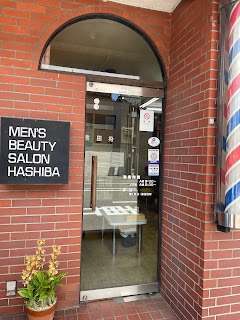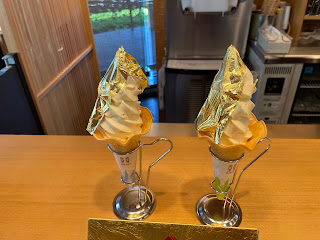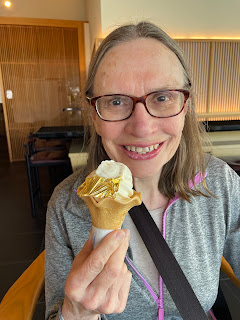After breakfast today we boarded our motor coach for a rather short drive to Kenrokuen Garden near the center of the city of Kanazawa. The garden is adjacent to Kanazawa Castle, the domain of Samurai warlords who ruled this area throughout Japan's Edo period.
The fifth lord of the domain started the garden for himself in 1676 C.E., and his successors added or modified it to their tastes until 1874, when the feudal system was abolished and the garden was opened to the public.
The garden is quite beautiful, with artificial lakes and ponds and wide varieties of trees and flowers. When one considers that the lakes were dug by hand and the soil moved by human labor, it's amazing that such a place was built only for the pleasure of a series of rulers and their families.
From the garden, the bus drove us to Omicho Fish Market. This has to be one of cleanest, most upscale fish markets on the planet. Almost all of the fish were already packaged in plastic.
There was hardly any fish smell at all. Many vendors would cook the fish for you on site. And of course, there were other items for sale besides fish. Mary found a bargain on a shirt.
This is a holiday week in Japan. Many schools are not in session. But for those that are, it's a popular time for school field trips. The garden and market were filled with groups of high school students in their uniforms. The boys' uniforms in this area are very similar to those of Imperial Navy officers during World War II. The girls' uniforms also have a nautical theme. Both girls and boys were happy to practice their English on us, and delighted to pose for photos. The girls personalize their bags with plush toy cartoon characters.
The bus took us next to the Higashichaya district. This is an area that escaped the ravages of war and contains many traditional style buildings dating back to the early 19th century.
Once private homes, these building are now restaurants and shops for jewelry and other high-end handicrafts.
Kanazawa has a long tradition as a center for crafts in gold leaf (more on this shortly), so products featuring gold leaf were everywhere -- from gold jewelry to gold leaf porcelain to gold cosmetics to gold ice cream.
We had a nice lunch in a restaurant here, although it was a little strange that the table was built around a post that blocked one's view of the people sitting across.
We had time to walk around, soak up the history, and visit the shops. There were more school groups. Someone heard that there were 50 school buses full of kids, as well as a lot of other people.
Next, the bus took us quite a way out of the city into an industrial area where we visited a gold leaf factory. This place makes gold leaf in the traditional way, albeit with mechanized hammers rather than guys pounding with mallets by hand.
We got to make a gold leaf postcard to take home as a souvenir. They made the process pretty foolproof, which was a good thing, given our skill level.
 |
| This gold leaf-decorated screen stands about 6 feet high and can be yours for about $13,000 plus tax and shipping. |
Some of the gold leaf artwork here was stunningly beautiful. The prices were pretty stunning, too.
But we broke down and joined the group in buying gold leaf ice cream cones. Yes, they make a soft serve cone and then wrap it with a piece of real gold leaf.
It's strictly a novelty. The gold is so thin (about one 10,000th of a millimeter) that it literally melts in your mouth and has no taste. Though the ice cream was pretty good.
The bus drove us back into the city and dropped us off in the "Samurai District." This is another area that features historic homes that have been preserved, but with a couple differences.
First, this neighborhood was the residence of the Samurai, the knights of the realm, if you will. So it was a ritzy zip code a couple hundred years ago.
Second, not all of the houses here were preserved. Only a few remain. We toured one, and it was worth the price of admission (550 Yen, or about $3.50).
 |
| The household altar for worshipping the ancestors. |
The home was about simplicity and unity with nature. But it was also largely unfurnished, so it was difficult to get a sense of how people lived in it.
 |
| The garden of the Samurai house |
The walk back to the hotel was just over a mile. We were looking for a bar or restaurant where we could have a drink and a snack. Amazingly, we came up empty on that quest.




















No comments:
Post a Comment